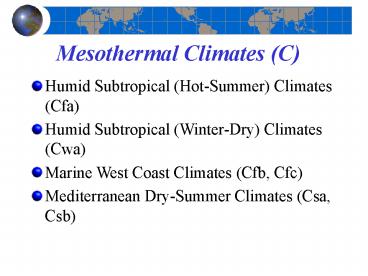Mesothermal Climates (C) - PowerPoint PPT Presentation
Title:
Mesothermal Climates (C)
Description:
Humid Subtropical (Winter-Dry) Climates (Cwa) Marine West Coast Climates (Cfb, Cfc) ... Polar Marine Climate (aka 'Polar Maritime') EM. More moderate than ... – PowerPoint PPT presentation
Number of Views:281
Avg rating:3.0/5.0
Title: Mesothermal Climates (C)
1
Mesothermal Climates (C)
- Humid Subtropical (Hot-Summer) Climates (Cfa)
- Humid Subtropical (Winter-Dry) Climates (Cwa)
- Marine West Coast Climates (Cfb, Cfc)
- Mediterranean Dry-Summer Climates (Csa, Csb)
2
Mesothermal Climates (C)
- Humid Subtropical (Winter-Dry) Climates (Cwa) C
warmest month above 10ºC, coldest month above
-3ºC seasonal climates - a hot summer, warmest month above 22ºC
- w winter dry (gt 70 of rainfall concentrated in
summer months)
3
Mesothermal Climates (C)
4
Microthermal Climates
- Humid Continental Hot-Summer Climates
- Dfa, Dwa
- Humid Continental Mild-Summer Climates
- Dfb, Dwb
- Subarctic Climates
- Subarctic Cool-Summer Dfc, Dwc
- Subarctic Extreme-Winter Dfd, Dwd
5
Microthermal Climates (D)
- Subarctic Climates (Dfc, Dwc, Dwd)
- Found poleward of Dfb and Dwb climate.
- Extensive geographically
- North America, stretching from Atlantic to
Pacific. - Eurasia, stretching from Scandinavia to the
Pacific. - Subarctic extreme-winter found only in eastern
Asia - Most extreme temperature ranges of all climates
- Extremely cold temperatures in winter primarily
due to - continental locations Siberian High in winter
- higher latitudes
- cP air masses
6
Microthermal Climates (D)
7
Polar and Highland Climates
- Tundra Climate (ET)
- Ice Cap and Ice Sheet Climates (EF)
- Polar Marine Climate (aka Polar Maritime) EM
- More moderate than other two polar climates
(why?) - No month below -7C (20F), but not as warm as
tundra climate - Low annual range of temperature
- Exists only along very fringes of highest
latitudes - Bering Sea (Alaska, Russia), southern Greenland,
northern Iceland, Norway)
8
Polar and Highland Climates
9
Chapter 10Climate Change
- Geosystems 6e
- An Introduction to Physical Geography
Robert W. Christopherson Charles E. Thomsen
10
Causes of Climate Change
- Variations in the Earths orbital characteristics
- Atmospheric carbon dioxide variations
- Volcanic eruptions
- Variations in solar output
- Humans
11
Greenhouse Gases
- Human activities are enhancing the Earths
natural greenhouse effect - Carbon dioxide, methane, nitrous oxide, CFCs, and
water vapor - Greenhouse gases are transparent to sunlight but
opaque to longwave radiation
12
(No Transcript)
13
Carbon Dioxide
- Atmospheric CO2 levels began rising during the
Industrial Revolution - Tremendous fossil fuel burning and heavy
deforestation increased CO2 levels this trend
continues - CO2 is responsible for 64 of global warming
14
Carbon Dioxide Sources
15
What are the Fossil Fuels?
16
Carbon Dioxide Sources
17
Methane
- Methane currently increasing faster than CO2 in
the atmosphere - 19 of total atmospheric warming attributed to
methane - Methane generated by rotting vegetation,
digestion in cattle and termites, burning of
vegetation, and melting permafrost
18
Methane (CH4)
19
Volcanic Eruptions
- Sulfur dioxide reacts with water vapor causing
haze - Combined with ejected particulate matter
- One of the coldest years in the last two
centuries was 1816, the Year Without a Summer - Caused by eruption of Tambora in 1815
- Temperatures can decrease after eruptions for up
to 3 years
Mount St. Helens
20
Variations in Solar Output
- Climate models predict that a change in solar
output of only 1 percent per century alters the
Earths average temperature by 0.5 -1.0 C - Sunspots
- Huge magnetic storms
- Seen as dark (cooler) areas
- on the sun's surface.
- Cycle every 11, 90, and
- 180 years
21
GCM Predictions
- Crop patterns and natural plant/animal habitats
will shift to maintain preferred temperatures - During this century, climate regions could shift
90-350 miles poleward - Soil moisture projected to decrease in
midlatitudes
22
GCM Predictions
- Forest cover will undergo major species
disturbances - Expansion of zones affected by tropical diseases
- Alpine glaciers
23
Global Temperatures
1.4C 2.5F
Figure 10.28
24
Temperature Anomalies for 2003
Figure 10.28
25
Sea Level Issues
During this century, global warming will cause
sea levels to rise at least 1.5 meters (about 4.5
feet).
26
Sea Level Rise
- During the 20th century, sea level rose 4-8
inches - Could rise 3.5-34.7 inches this century
- Thermal expansion of water will increase sea
level rise - Higher sea levels destruction of small island
nations, river deltas, lowland coastal farming,
barrier islands
27
July 2029 Temperature Forecast
Figure 10.31
28
Disintegration of Ice Shelves
- In 2002, Larsen-B ice shelve collapsed in 35 days
after existing for 11,000 years - Warmer ocean and air temperatures are melting
shelves on both sides - Clear evidence of changes in Earths energy
balance
29
Antarctic Ice Disintegration
Figure 10.32
30
Arctic Climates
- Changes in ocean temperatures could alter global
temperatures - Arctic region warmed 9F since 1987
- This has led to a freshening of northern oceans
- Greenland ice melting at 1m/year
- Permafrost is melting
- Increased precipitation in Arctic/Antarctic areas
31
End of Chapter 10Climate Change
- Geosystems 6e
- An Introduction to Physical Geography
Robert W. Christopherson Charlie Thomsen































